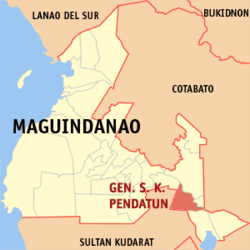General Salipada K. Pendatun, Maguindanao
| General Salipada K. Pendatun | |
|---|---|
| Municipality | |
| Municipality of General Salipada K. Pendatun | |
 Map of Maguindanao with General Salipada K. Pendatun highlighted | |
.svg.png) General Salipada K. Pendatun Location within the Philippines | |
| Coordinates: 6°47′49″N 124°42′09″E / 6.79694°N 124.7025°ECoordinates: 6°47′49″N 124°42′09″E / 6.79694°N 124.7025°E | |
| Country |
|
| Region | Autonomous Region in Muslim Mindanao (ARMM) |
| Province | Maguindanao |
| District | 2nd District |
| Barangays | 19 (see Barangays) |
| Government [1] | |
| • Type | Sangguniang Bayan |
| • Mayor | Shajid Khan P. Pendatun |
| • Electorate | 12,772 voters (2016) |
| Area [2] | |
| • Total | 189.37 km2 (73.12 sq mi) |
| Population (2015 census)[3] | |
| • Total | 28,103 |
| • Density | 150/km2 (380/sq mi) |
| Time zone | UTC+8 (PST) |
| ZIP code | 9618 |
| PSGC | 153819000 |
| IDD : area code | +63 (0)64 |
| Climate type | Tropical climate |
| Income class | 4th municipal income class |
| Revenue (₱) | 78,967,015.59 (2016) |
| Native languages |
Maguindanao language Tagalog |
| Website |
www |
General Salipada K. Pendatun, officially the Municipality of General Salipada K. Pendatun, is a 4th class municipality in the province of Maguindanao, Philippines. According to the 2015 census, it has a population of 28,103 people.[3]
It is named for General Salipada K. Pendatun (1912 – 1985), who is a forerunner Mindanaoan Legislator and General during the Second World War.
Barangays
General Salipada K. Pendatun is politically subdivided into 19 barangays.[4]
- Badak
- Bulod
- Kaladturan
- Kulasi
- Lao-lao
- Lasangan
- Lower Idtig
- Lumabao
- Makainis
- Midconding
- Midpandacan
- Panosolen
- Pidtiguian
- Quipolot
- Ramcor
- Sadangin
- Sumakubay
- Tonggol
- Upper Lasangan
History
On April 7, 1991, Muslim Mindanao Autonomy Act No. 3 created the Municipality of General S. K. Pendatun out of the municipality of Buluan,[5][6] making it the first local government unit created by the ARMM Regional Assembly.[7] The municipality of Paglat was created out of four of its barangays on September 29, 2001.[8]
Demographics
| Population census of Gen. S. K. Pendatun | ||
|---|---|---|
| Year | Pop. | ±% p.a. |
| 1995 | 20,280 | — |
| 2000 | 28,374 | +7.46% |
| 2007 | 36,038 | +3.35% |
| 2010 | 24,004 | −13.75% |
| 2015 | 28,103 | +3.05% |
| Source: Philippine Statistics Authority[3] [9] [10] [11] | ||
References
- ↑ "Municipality". Quezon City, Philippines: Department of the Interior and Local Government. Retrieved 31 May 2013.
- ↑ "Province: Maguindanao". PSGC Interactive. Quezon City, Philippines: Philippine Statistics Authority. Retrieved 12 November 2016.
- 1 2 3 Census of Population (2015). "ARMM – Autonomous Region in Muslim Mindanao". Total Population by Province, City, Municipality and Barangay. PSA. Retrieved 20 June 2016.
- ↑ National Statistical Coordination Board. "PSGC Interactive: Municipality/City: GEN. S. K. PENDATUN". Retrieved 2008-05-20.
- ↑ "Regional Act No. 3; An Act Creating the Municipality of General Salipada K. Pendatun in the Province of Maguindanao, Appropriating Funds Therefor, and for Other Purposes" (PDF). Regional Legislative Assembly, Autonomous Region in Muslim Mindanao. Retrieved 27 January 2016.
- ↑ Philippine Statistics Authority (2001-04-23). "Census 2000 Final Counts". Archived from the original on 2007-11-26. Retrieved 2008-05-20.
- ↑ Institute for Autonomy and Governance. "List of MMA Acts" (PDF). Archived from the original (PDF) on 2011-10-09. Retrieved 2008-05-20.
- ↑ Philippine Statistics Authority (2008-04-16). "2007 Census of Population: Autonomous Region in Muslim Mindanao" (PDF). Archived from the original (PDF) on 2008-09-05. Retrieved 2008-05-19.
- ↑ Census of Population and Housing (2010). "ARMM – Autonomous Region in Muslim Mindanao". Total Population by Province, City, Municipality and Barangay. NSO. Retrieved 29 June 2016.
- ↑ Censuses of Population (1903–2007). "ARMM – Autonomous Region in Muslim Mindanao". Table 1. Population Enumerated in Various Censuses by Province/Highly Urbanized City: 1903 to 2007. NSO.
- ↑ "Province of Maguindanao". Municipality Population Data. Local Water Utilities Administration Research Division. Retrieved 17 December 2016.